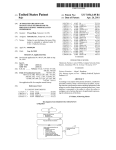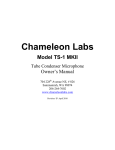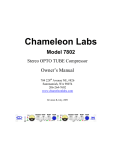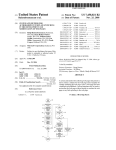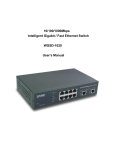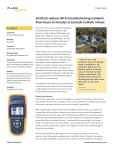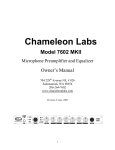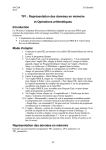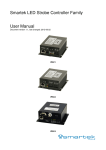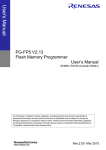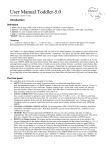Download System and method for" Plug and Play" ability to broadband network
Transcript
US 20030061315A1 (19) United States (12) Patent Application Publication (10) Pub. No.: US 2003/0061315 A1 (43) Pub. Date: J in (54) Mar. 27, 2003 SYSTEM AND METHOD FOR ”PLUG AND and at least one auto con?guration and monitoring server. A PLAY” ABILITY TO BROADBAND NETWORK BASED CUSTOMER DEVICES netWork protocol called Plug and Play Host Protocol (PPHP) (76) Inventor: Frank Kui J in, Sammamish, WA (US) Correspondence Address: identi?ed and con?gured through the auto con?guration FRANK K. J IN 20041 SE 24th St. server. If the identi?cation and con?guration information are lacking, the customer device sends an identi?cation and Sammamish, WA 98075 (US) (21) Appl. No.: 10/244,116 (22) Filed: Sep. 16, 2002 is de?ned to facilitate the automatic connections betWeen an auto con?guration server and a number of uncon?gured broadband customer devices or netWork computers. The customer device determines on poWer on time if it has been con?guration request to the auto con?guration server using Related US. Application Data (60) Provisional application No. 60/324,503, ?led on Sep. 25, 2001. Publication Classi?cation a multicast message With a prede?ned multicast group. Upon receiving the identi?cation request from a neW cus tomer device, the auto con?guration server chooses a unique computer name for the customer device and sends the computer name along With some other initialization infor mation to the customer device using another multicast message With another prede?ned multicast group. The cus tomer device uses the unique computer name and other con?guration information received to con?gure itself and (51) Int. Cl.7 ....................... .. G06F 15/177; G06F 15/16 establish connections to the service providers in the net (52) US. Cl. .......................................... .. 709/220; 709/203 Work. After the initial discovery and con?guration phase, the (57) ABSTRACT A distributed broadband netWork comprises of uncon?gured broadband-based customer devices or netWork computers ‘ connection channels established betWeen an auto con?gu ration server and a plurality of managed customer devices are used continuously for automatic monitoring and remote management of the customer devices. 1 SIGNON Message (ACC to Acs) 1 2 iNlT Message (AC5 to A00) 1 Mqlrticast 3 INIT’DONE Message (ACCtu AC5) Acronym Router AC8 auto configuration server SRA subnet relay agent ACC: auto configuration client SRA i SIGNON Message moo w sRAi, 4.iNiT Message iSRA to ACC) 5 iNiT’DONE Message (Ace tn SRA) 1 Patent Application Publication Mar. 27, 2003 Sheet 1 0f 3 US 2003/0061315 A1 Segment/Subnet 1 IP address: 192.168.0.X Mask: 255.255.255.128 ' i» I “Ethernet "I V. ,_j Segment 2 IP address: 172.16.0.X Mask: 255.255.0.0 Subnet 2 IP address: 192.168.0.X Mask: 255.255.255.192 Acronym ACS: auto con?guration server SRA: subnet relay agent ACC: auto configuration client Patent Application Publication Mar. 27, 2003 Sheet 2 0f 3 US 2003/0061315 A1 ACS ACC 1 SIGNON Message (ACC to ACS) 2. |N|T Message (AC8 to ACC) 3 IN|T_DONE Message (ACCto AC5) Acronym ACS: auto configuration server SRA: subnet relay agent ACC: auto configuration client SRA Mm n - M» M 1 1.7 7SIGNON Message (ACC toMulticast SRA) 4i lNlT Message (SRA to ACC) 5. INIT_DONE Message (ACC to SRA) Patent Application Publication Mar. 27, 2003 Sheet 3 0f 3 US 2003/0061315 A1 Figure 3 l l l I l i | N i ‘ \ Configurator vi‘ CIDB i 3 I , ____ PPHP Server l | ‘ i é’) (2) | (D 1 ' | E /\ l ' | : ACC ‘\(LD : e | V ACC *\_@ MuIticast/unicast : : . AC0 \@ t 0 u: | | 3 : a : g l m a A“ \Q) I '1 | 2’ I g I Unlcast | : : ACC(s) and ACS in the same segment or subnet = m l a Il a : I _________________________________________ "1; l t I Subnet Relay I Agnet : 6 | i : l i m i | | 0 ‘a 1 l 3 : i : ACC “@ ——l\ ACC *\@ Multicasl a | l \/‘ f‘ 2 : ‘4W l/ v \l__7 g i : ACC -\@ a I l "" i | N I I l ACC *\@ ACC(s) and SRA in the same segment or subnet, different from ACS. Acronym ACS: auto configuration server SRA: subnet relay agent ACC: auto configuration client I l l l Mar. 27, 2003 US 2003/0061315 A1 SYSTEM AND METHOD FOR ”PLUG AND PLAY” ABILITY TO BROADBAND NETWORK BASED CUSTOMER DEVICES CROSS REFERENCE TO RELATED APPLICATIONS [0001] This application is related to US. provisional patent application No. 60/324,503 still pending, entitled “System and method for ‘Plug and Play’ ability to broadband netWork based customer devices”, ?led on Sept. 25, 2001, Which is hereby incorporated by reference. the con?guration process on the client side is as simple as plugging in the broadband connection and turning on the poWer for each customer device. Thus, the con?guration of the broadband-based customer device is completely trans parent to the end user. Furthermore, the invention provides the ability to automatically monitor and remotely manage broadband-based customer devices from a centraliZed auto con?guration server. [0007] In summary, the present invention is a system and method for the automatic con?guration and remote manage ment of broadband-based customer devices from a central iZed auto con?guration server. The auto con?guration server BACKGROUND OF THE INVENTION has a client information database (CIDB) that contains all of [0002] A TCP/IP based broadband customer device, such as a high end settop boX, is actually a high performance netWork computer. These broadband customer devices typi cally roll off a production line With the same operation device. The core of the invention is a client-server commu the con?guration information for each managed customer image. That means that all of the customer devices have the eXact same netWork identity and a default con?guration When they leave the production line. They have to undergo some sort of con?guration procedure before they can be used in a speci?c intranet environment by end users. The nication protocol betWeen the auto con?guration server and the managed customer devices, Which is called as Plug and Play Host Protocol (PPHP), as summariZed beloW. The communication mechanism established by using PPHP betWeen the auto con?guration server and managed cus tomer devices can be used to perform automatic monitoring and remote management of the managed customer devices from the centraliZed auto con?guration server. most important step in this con?guration procedure is to set a proper netWork identity for each of the customer devices [0008] in an intranet based on a prede?ned scheme. There are communication sequences betWeen a PPHP server (part of The PPHP speci?es shared multicast groups and usually some other con?guration steps in the con?guration the auto con?guration server) and multiple PPHP clients procedure, such as setting up IP addresses for different (broadband-based customer devices). A PPHP server should be con?gured and up running before any PPHP clients can netWork servers in the customer devices. Because these in a customer environment, it is desirable that the con?gu be connected to the netWork. The PPHP server must join SIGNON_SVR, a prede?ned multi-cast group, to Wait for ration procedure can be performed automatically Without the connection requests from any PPHP clients. In addition, customer devices are usually deployed With a large quantity any user intervention. [0003] The con?guration methods currently used can be classi?ed as either (a) sending a trained technician to cus tomer sites to do the manual con?guration for each customer device or each netWork computer; (b) shipping a detailed con?guration manual With each broadband-based customer device and asking the end user to perform the con?guration by reading the User’s Manual. Neither of the methods is suitable for a large-scale deployment of the broadband based customer devices because of the need of the manual con?guration on the client side. [0004] After the initial netWork con?guration to all of the managed customer devices, hoW to monitor and manage them remotely on the daily basis is another major concern to the service providers. Therefore, a platform that provides the mechanism for remote and automatic management of broad band customer devices in a point-to-points mode Without using any signi?cant bandWidth is much needed for IT personnel to manage a large number of the broadband based customer devices ef?ciently. the server needs to setup a unicast port called SVR_ACK _PORT to listen acknowledgements and some potential errors from clients. [0009] When a neW PPHP client ?rst appears on the netWork, it joins INIT_GROUP, another prede?ned multi cast group, and sends out a con?guration request, SIGNON, With its identi?cation information to the PPHP server using a multicast message to SINGON_SVR. Upon receiving the SIGNON message from a neW client, the server builds up an initialiZation message using the information from CIDB and the client’s request. Then it sends out the initialiZation message, INIT, to INIT_GROUP as a multicast message because at this point the client Who supposes to get the message may have not been con?gured With a proper IP address. Because of the hardWare identi?cation contained in the initialiZation message, the targeted client Will be the only one to process the INIT message. The client must send the con?guration request repeatedly until it receives its initial iZation message. After processing the initialiZation message, the client must send an INIT_DONE message to SVR_ACK_PROT. Then the client needs to join GEN [0005] The system and method presented in this invention CONFIG_GROUP, a prede?ned multicast group for a com provide a complete solution to both of the automatic initial con?guration and daily remote management to the broad mon con?guration update, and listen on SPE_CFG_PROT, band-based customer devices. update. BRIEF SUMMARY OF THE INVENTION [0006] The present invention overcomes the shortcoming of the above-mentioned methods by providing a completely automated system and method for con?guring and monitor ing broadband-based customer devices. With this invention, a prede?ned unicast port for any speci?c con?guration [0010] The invention completely eliminates the need to do any manual con?guration on the client side for broadband based customer devices or any netWork computers that support TCP/IP multicasting. The administrator uses the auto con?guration server to con?gure all of the managed PPHP clients. After the initial con?guration, the PPHP Mar. 27, 2003 US 2003/0061315 A1 clients-server infrastructure is used for daily system updates and performance monitoring of the broadband-based cus processed the INIT message. The message contains: message ID that is INIT_DONE, the client’s com tomer devices. puter name, and etc. BRIEF DESCRIPTION OF THE DRAWINGS [0020] 4. GEN_CONFIG Message: This is a multi cast message that is used for the server to send FIG. 1 is a typical network topological structure general con?guration updates to a number of clients. Wherein there are an auto con?guration server (ACS), a [0011] The message contains: message ID that is GEN _CONFIG, a serial number to identify this GEN number of auto con?guration clients (ACC) located in different subnets or segments and tWo subnet relay agents (SRA). [0012] FIG. 2 illustrates the PPHP messages among an ACS, a SRA and a number of ACCs. As described in the diagram, a SRA is responsible to relay all of the PPHP multicast messages from the ACCs Within the same subnet _CONFIG message, hostname mask that de?ne the group to receive the message, a list of con?guration data and etc. [0021] 5. GEN_CFG_ACK Message: This is a uni cast message from a client to the server to acknoWl edge the receiving of a speci?c GEN_CONFIG or segment to a connected ACS. All of the PPHP unicast messages are communicated directly betWeen an ACS and message. The message contains: message ID that is ACC(s). name and etc. [0013] FIG. 3 is a system block diagram for the invention. It gives more details about the components in an ACS. DETAILED DESCRIPTION OF THE INVENTION [0014] This invention creates a netWork system structure, as illustrated in FIG. 1, Which comprises ?ve major sub systems: a Con?gurator, a PPHP Server, a Client Informa GEN_CFG_ACK, the serial number and the host [0022] 6. SPE_CONFIG Message: This is a unicast message from the server to a speci?c client to update the client’s con?guration. The message contains: message ID that is SPE_CONFIG, a serial number, a list of con?guration data and etc. [0023] 7. CLIENT_ERR Message: This is a unicast message for a client to report some error conditions tion Database (CIDB), and a plurality of PPHP Clients and to the server. The message contains: message ID that a plurality of PPHP Relay Agents. As displayed in FIG. 3, is CLIENT_ERR, hostname, the message ID that the an Auto Con?guration Server (ACS) is comprised of a Con?gurator, a PPHP Server and a CIDB. A PPHP Client can also be called as an Auto Con?guration Client (ACC). error is related to, error message and etc. A PPHP Relay Agent is also called as a Subnet Relay Agent (SRA). The ?ve subsystems are related together by Plug and Play Host Protocol (PPHP) as described beloW. [0015] The core idea for PPHP is to provide a reliable mechanism using multicast communications to let netWork computers automatically get their netWork con?guration information from a centraliZed server even before the net Work computers are properly con?gured. The only assump tion PPHP made is that the netWork supports TCP/IP mul ticasting. [0024] 8. STILL_ALIVE Message: This is a unicast message sent from a client to server’s SVR_ACK _PORT periodically. The message contains: message ID that is STILL_ALIVE, hostname and etc. [0025] PPHP de?nes folloWing multicast groups and socket ports: [0026] 1. SIGNON_SVR: This multicast group is used to facilitate the initial connections betWeen a server and a number of clients before the netWork con?gurations of the clients are properly done. The PPHP Server is the only one to join the group and listen to SIGNON requests from a number of clients. [0016] PPHP speci?es a series of messages used to estab lish the connections and facilitate the communications A neW PPHP client needs to send a multicast mes betWeen a PPHP Server and a number of PPHP Clients, as sage, SIGNON, to this group. described in FIG. 2. [0017] 1. SIGNON Message: This is a multi-cast message that is used by a neW client to connect to a PPHP Server through a prede?ned multi-cast group. The message contains: message ID that is SIGNON, MAC address of the computer, and etc. [0018] 2. INIT Message: This is also a multicast message that is used by the PPHP Server to send the initialiZation data to a speci?c neW client. The mes sage contains: message ID that is INIT, MAC address of the targeted client machine, computer name that is assigned to the client machine, the PPHP Server’s IP address/host name and the server’s unicast listening port, and etc. [0019] 3. INIT_DONE Message: This is a unicast message from a client to the server’s listening port to notify the server that the client has successfully [0027] 2. INIT_GROUP: this is a multicast group that all of the clients Will join in initially to receive the initial INIT packages from the server. A PPHP server uses this group to send out the multicast message, INIT, to neW PPHP clients. [0028] 3. GEN_CONFIG_GROUP: this multicast group is used to implement the con?guration updates for the Whole group or part of the group. All of PPHP clients join in this group and a PPHP server sends out multicast message, GEN_CONFIG, to this group. [0029] 4. SVR_ACK_PORT: this is the server port to listen the acknoWledgements or some potential errors from clients. [0030] 5. SPE_CFG_PORT: this is the client port to receive customiZed con?guration messages from the server. Mar. 27, 2003 US 2003/0061315 A1 [0031] To establish an initial connection between a PPHP server and PPHP clients, and con?gure the clients as speci ?ed, the following sequence of messages Will be sent betWeen the server and clients. [0032] 1. PPHP clients join INIT_GROUP multicast group to listen to INIT messages. Then, in order to look for a PPHP server, every PPHP client Will send out SIGNON request to multicast group, SIGNON_SVR, repeatedly until it receives the INIT message speci?c for itself. [0033] 2. After the server receives a SIGNON mes sage, it builds up an INIT message using the infor mation from CIDB and the SIGNON message. Then it sends out the INIT message to INIT_GROUP. [0034] 3. All of the clients in INIT_GROUP Will receive every INIT message the server send out. But only the client found a matching MAC address processes the message. [0035] must 4. After processing INIT message, the client send out an INIT_DONE message to SVR_ACK_PORT. At this time, the client needs to create tWo listening sockets: one is to join GEN _CONFIG_GROUP; the second is on SPE_CFG _PORT. [0036] PPHP requires that the computer name for each client computer must be unique. When DHCP is used to assign an IP address to a client computer, the computer name is the only unique ID for the client. When a static P is used for a client computer, PPHP still uses the unique computer name to identify the client. This gives the system the ability to sWitch the IP address type back and forth betWeen DHCP and static IP for a client computer. PPHP provides three schemes to assign a unique computer name to a neW client computer (or a neW customer device) as described beloW. [0037] Scheme One: Apool of unique computer names is prede?ned and stored in a CIDB on the server side. For each neW connected client, the server Will pick up a unique name computer to let an end user to enter a matching name, and then assign the matched name to the client computer. [0040] The Con?gurator, as described in FIG. 3, is a utility subsystem to alloW netWork administrators to specify the con?gurations to each managed client computers. In order to save user’s time to survey current client informa tion, the Con?gurator searches all connected clients using multicast communications even before they are properly con?gured. Therefore a user does not have to type in all of the computer names for each managed client computers if they don’t Want to change them. The client netWork con ?gurations that can be speci?ed With the Con?gurator include computer name, IP address, static IP or DHCP, DNS, WINS, GateWay IP and etc. After specifying the netWork con?gurations for each managed client, the information Will be saved in CIDB to share betWeen the Con?gurator and a PPHP Server. [0041] The PPHP Server, as described in FIG. 3, is the subsystem that monitors and manages all of PPHP clients at real time. It acquires the information about all of the managed clients from CIDB and also Writes all of updated information about the managed clients back to CIDB. For each neW client, the server is responsible to listen to the SIGNON request, and build up and send out the INIT message. Then it also updates the connection status on the server UI and in CIDB. After the connection phase, the server Will manage the STILL_ALIVE messages periodi cally sent from each connected client to update the client connection status. At runtime, the connection channels betWeen the server and managed clients are used to remotely update the con?gurations, manage the client systems and distribute ?les, and etc. [0042] The Client Information Database (CIDB), as described in FIG. 3, is a central depositary for all of client related information. AsynchroniZation mechanism has been implemented in CIDB because it is a shared database betWeen Con?gurator and PPHP Server. CIDB is a real time database. The information and status for each online client can change at any time and the record for each client in CIDB must be updated accordingly. sequentially from the pool and assign the name to the neW client automatically. This is the simplest Way to assign a unique computer name to a client computer. The only Way [0043] The PPHP Client or ACC as described in FIG. 3 runs in each managed customer device or client computer. It to associate a client computer to a speci?c name in this is responsible to send out SIGNON request repeatedly until it receives the INIT message eXpected. After processing the scheme is to control the sequence of the connection to the server for each client. For eXample, if you Want a client computer to get the third name in the pool, you need to make sure that the client is the third computer to connect to the server, and so on. INIT message, it Will send out INIT_DONE message to the server. Then it sends out STILL_ALIVE messages periodi cally to maintain the connection With the server. While connected, it listens to messages from the server on GEN _CONFIG_GROUP and SPE_CFG_PORT, and processes [0038] Scheme TWo: A root name is prede?ned on the server side. For each neW connected client, a popup WindoW comes out on the client computer to let an end user to enter a client feature ID, such as a room number in a hotel. Then the system Will automatically build up a full computer name using the root name from the server and the client feature ID, and assign the name to the client computer. [0039] Scheme Three: A pool of unique computer names is prede?ned on the server side. For each neW connected the messages to update the client system or perform some required tasks. [0044] The PPHP Relay Agent or SRA as described in FIG. 3 is a subsystem to expand the applied scope of PPHP into the netWork Where more than one subnets or segments eXist. As described above, the core idea for PPHP is to automatically con?gure netWork computers from a central iZed server using multicasting. HoWever, multicasting mes client, the server requires the client to provide a computer sages usually cannot travel across different subnets or seg ments. To make PPHP Work for multiple subnets or name that matches one of the names in the pool. If the segments, the PPHP Relay Agents are used to relay the eXisting name in the client computer does not match any PPHP multicasting messages betWeen a PPHP Server and PPHP Clients located in different subnets or segments. The name in the pool, a popup WindoW comes out on the client Mar. 27, 2003 US 2003/0061315 A1 communications between a PPHP Server and a PPHP Relay Agent are point-to-point TCP communication. The commu nications betWeen a PPHP Relay Agent and the PPHP clients only eXist for a short period of time to conduct a short-term Within the same subnet or segment are multicasting com alive message periodically to the thread manager. There are tWo types of constant threads in the system: recoverable and non-recoverable. A recoverable thread is a thread that does not depend on other Working threads. Therefore the thread munication. [0045] As described in FIG. 2, for a network With multiple subnets or segments, PPHP Will Work as folloWing: [0046] 1. All of the PPHP clients join a prede?ned multicasting group, INIT_GROUP, to receive INIT messages from a PPHP server. [0047] 2. A PPHP client sends out SIGNON mes sages repeatedly to the prede?ned multicasting group, SIGNON_SVR, until it receives an INIT message speci?cally for itself. [0048] 3. A PPHP relay agent joins SIGNON_SVR group and receives all of the SIGNON messages manager can restart a recoverable thread individually at runtime if necessary. A non-recoverable thread is the one that cannot be restarted individually. Therefore the thread manager has to restart the Whole system to recover from a failed non-recoverable thread. If one of the managed thread runs into a problem and stops sending the still-alive mes sages, the thread manager Will check the thread type ?rst. If it is a recoverable thread, the thread manager Will restart the thread to ?X the problem. If it is a non-recoverable thread, the thread manager Will restart the PPHP Server as a Whole. 4. After receiving a SIGNON message from [0057] To handle short-term tasks for a large number of client computers in a random mode, such as processing SIGNON messages, a groWable thread pool is created in the the SIGNON_SVR multicasting group, the PPHP system. While the number of pending tasks is loW, the pool from the same subnet or segment. [0049] relay agent relays the message to a PPHP server maintains a minimum number of threads. While the number using point-to-point TCP message. of simultaneous tasks increases, the number of threads in the [0050] 5. A PPHP server joins SIGNON_SVR mul ticasting group and also listens to all of the ports connected to PPHP relay agents. pool groWs too up to a limit to handle the spontaneous tasks. For eXample, Whenever a PPHP Server receives a SIGNON message, it dispatches a thread from the pool to process the 6. After receiving a SIGNON message from SIGNON message. After ?nishing the task, the thread Will return to the pool for neXt pending task. If the number of the SINGON_SVR multicasting group, the PPHP pending tasks eXcesses the number of available threads in server builds up an INIT message using the infor mation from CIDB and the SIGNON message for the client. Then it sends out the INIT message to the threads up to a prede?ned limit to handle the spontaneous [0051] multicasting group, INIT_GROUP. [0052] 7. After receiving a SIGNON message from a port of a connected PPHP relay agent, the PPHP server builds up an INIT message using the infor mation from CIDB and the SIGNON message for the client. Then it sends out the INIT message to the the pool, the pool Will automatically increase the number of tasks. While the number of pending tasks becomes loW, the pool Will automatically decrease the number of the threads in the pool to effectively conserve the system resources. [0058] Other embodiments, combinations and modi?ca PPHP relay agent by using a point-to-point TCP tions of this invention Will occur readily to those of ordinary skill in the art in vieW of these teachings. Therefore, this invention is to be limited only to the folloWing claims, Which include all such embodiments and modi?cations When communication. vieWed in conjunction With the above description and [0053] 8. After receiving an INIT message from the PPHP server, the PPHP relay agent sends out the INIT message to multicasting group, INIT_GROUP, using multicasting communication. [0054] 9. After receiving the matching INIT message on INIT_GROUP, a PPHP client processes the mes sage by con?guring the local system using the infor mation from the INIT message. [0055] 10. After the con?guration, the PPHP client sends out an INIT_DONE message to the PPHP server With a point-to-point TCP message. [0056] task. All of constant threads are managed directly by the thread manager. Every constant thread needs to send still Because a centraliZed ACS may need to manage several hundreds or even thousands of ACCs, thread man agement is a critical issue in the implementation of the system. The present invention creates an ef?cient thread management method as described beloW. A thread manager is implemented to create and manage all of other Work threads directly or indirectly. There are tWo categories of Working threads in the system: constant threads and tempo rary threads. A constant thread is the one that alWays eXists Whenever the system is up running. A temporary thread may accompanying draWings. I claim: 1. A system for automatic con?guration of broadband customer devices, comprising of: an auto con?guration server (ACS); a plurality of Subnet Relay Agents (SRA); and a plurality of auto con?guration clients (ACC). 2. A method for automatic con?guration of broadband customer devices, comprising the steps of: Receiving requests from the broadband customer devices for auto con?guration; Receiving client identi?cation information With each of the requests, Wherein the client identi?cation informa tion includes the MAC address and the alias, such as a room number or phone number, associated With the broadband customer device; Using the received client identi?cation information and a prede?ned client information database (CIDB) to deter mine a computer name for the customer device; Mar. 27, 2003 US 2003/0061315 A1 CIDB to build a con?guration package for each man 6. The method of claim 2, Wherein sending and receiving auto con?guration packages using a prede?ned multi-cast aged client and send the con?guration package to the group. Using the received client identi?cation information and corresponding ACC; Receiving and processing the con?guration package from acs to con?gure the broadband device for netWork communication. 3. The method of claim 2, Wherein the computer name determined based on a client identi?cation information and a prede?ned CIDB is a human-friendly name and is used as 7. The method of claim 2, Wherein the autocon?guration attempt is conducted repeatedly until all of the managed clients are successfully con?gured. 8. The client information database (CIDB) of claim 2 is a central depository of all of client related information, Which can be processed in real time. 9. The system of claim 1, Wherein each PPHP Relay Agent the unique ID for the customer device in the system. 4. The method of claim 3, Wherein the unique computer name for each managed customer device is obtained through relays all of multi-cast communications betWeen the ACS one of the three schemes: and ACCs in its oWn subnet. Automatically assigning a unique name to a neW client (SRA) establishes a direct TCP connection With an ACS and 10. The system of claim 1, Wherein the connections from a pool of prede?ned unique computer names; among ACS, SRAs and ACCs are used for the further Combining a prede?ned root name and a client’s feature ID, such as a room number, to form a unique computer con?guration and management of the broadband customer devices. 11. The system claim 1, Wherein the combination of a thread manager and a thread pool is used to provide reliable name for a client; Providing a name by a client that matches one of the unique names prede?ned in the CIDB. 5. The method of claim 2, Wherein sending and receiving auto con?guration requests using a prede?ned multi-cast group. thread management and the ability to handle spontaneous tasks in an ACS.









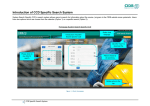
![PROTECTION] 5 E](http://vs1.manualzilla.com/store/data/005801803_1-bb6b523a92d2b05d032451f5b800ca8c-150x150.png)
